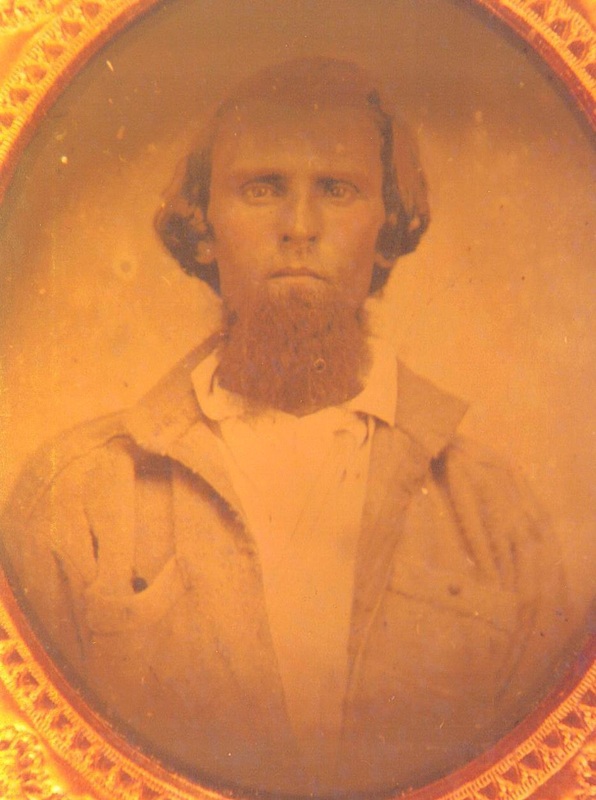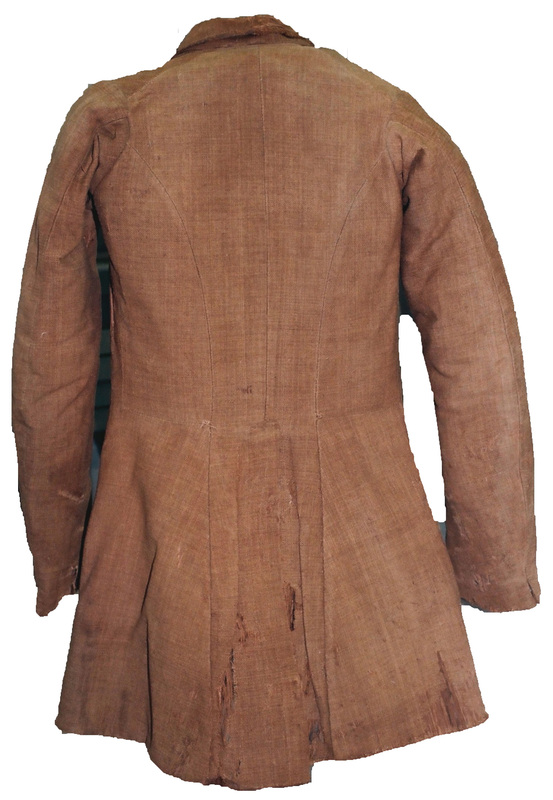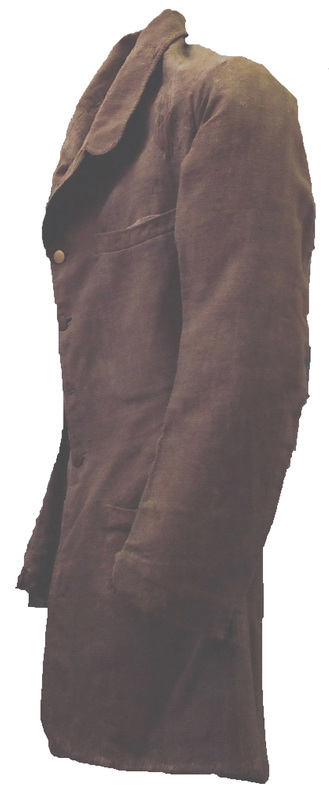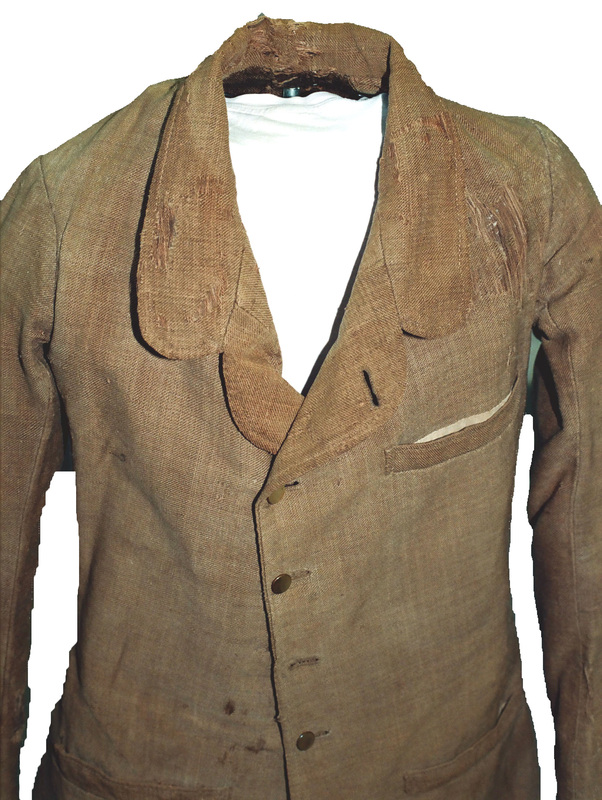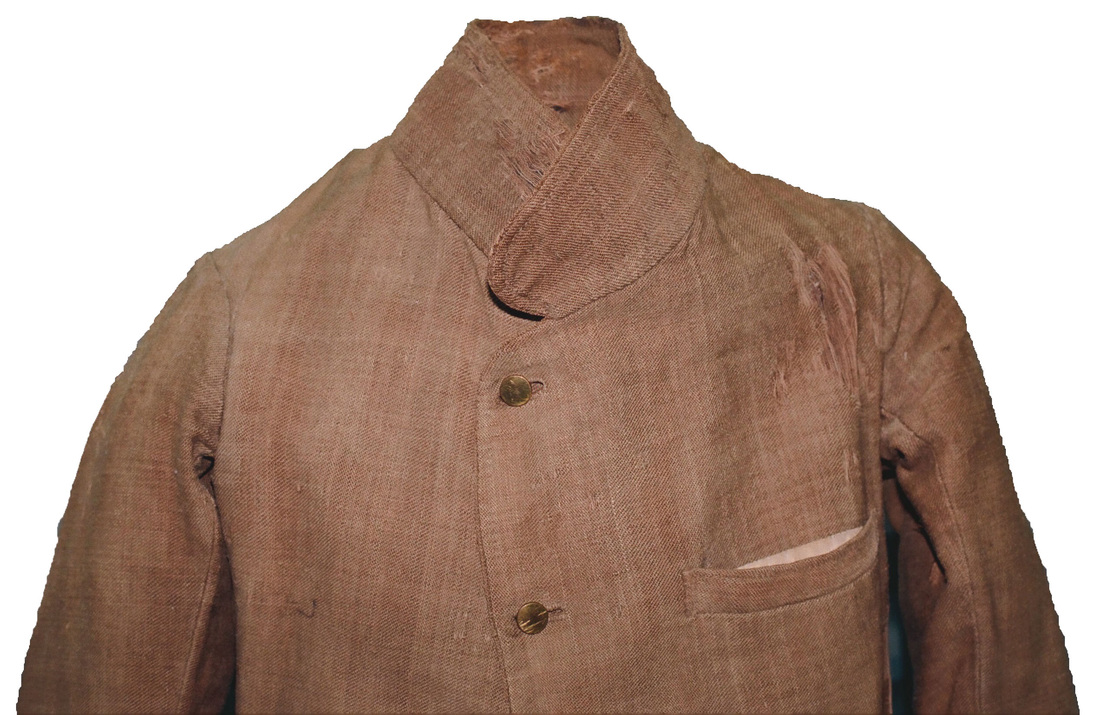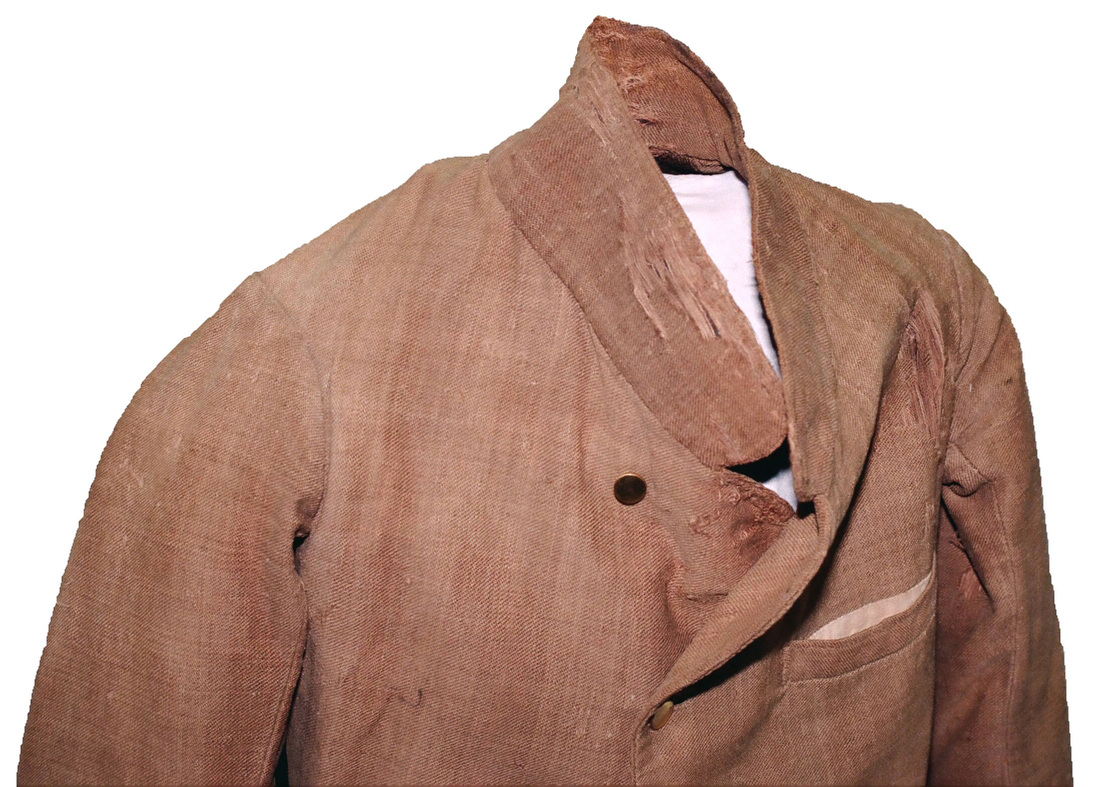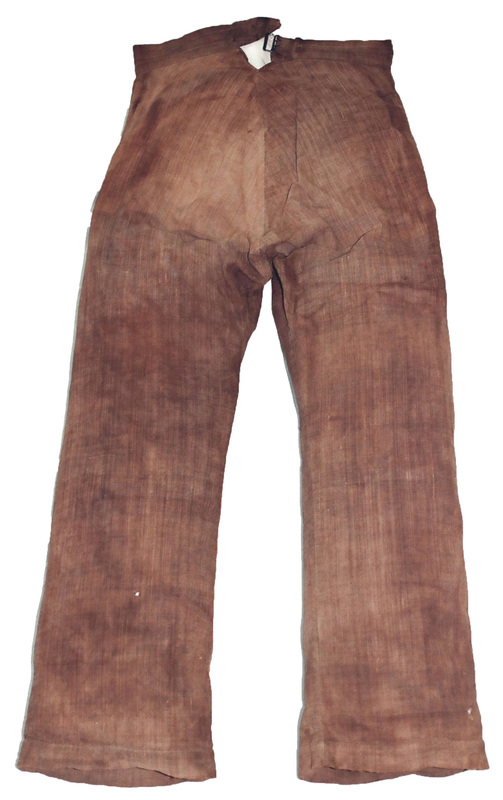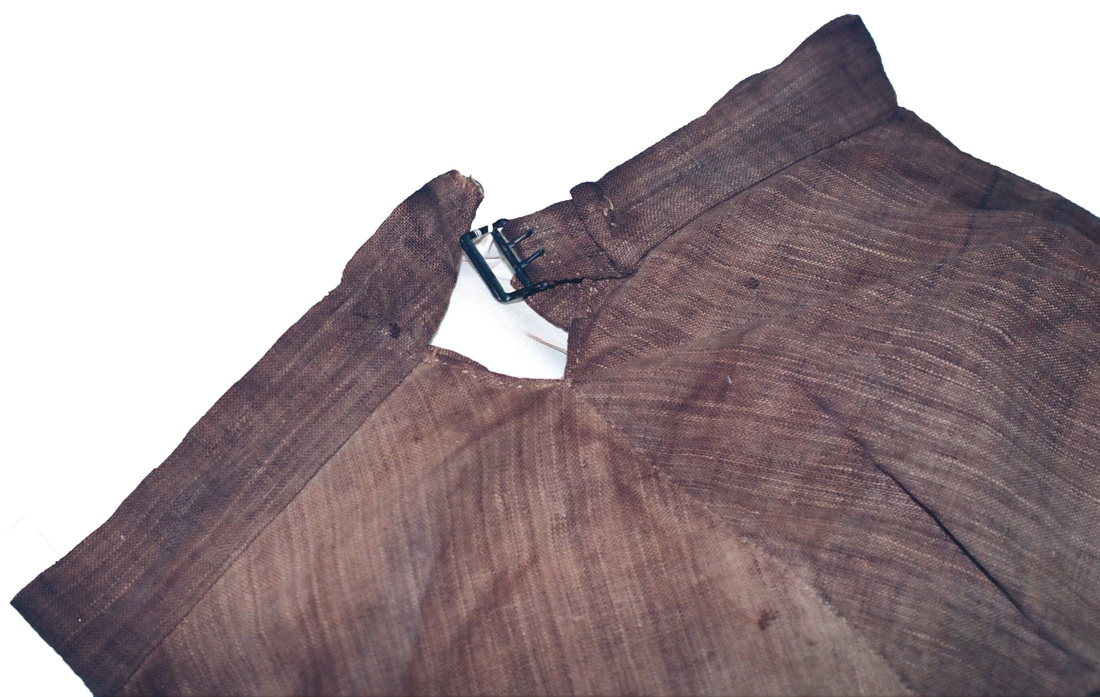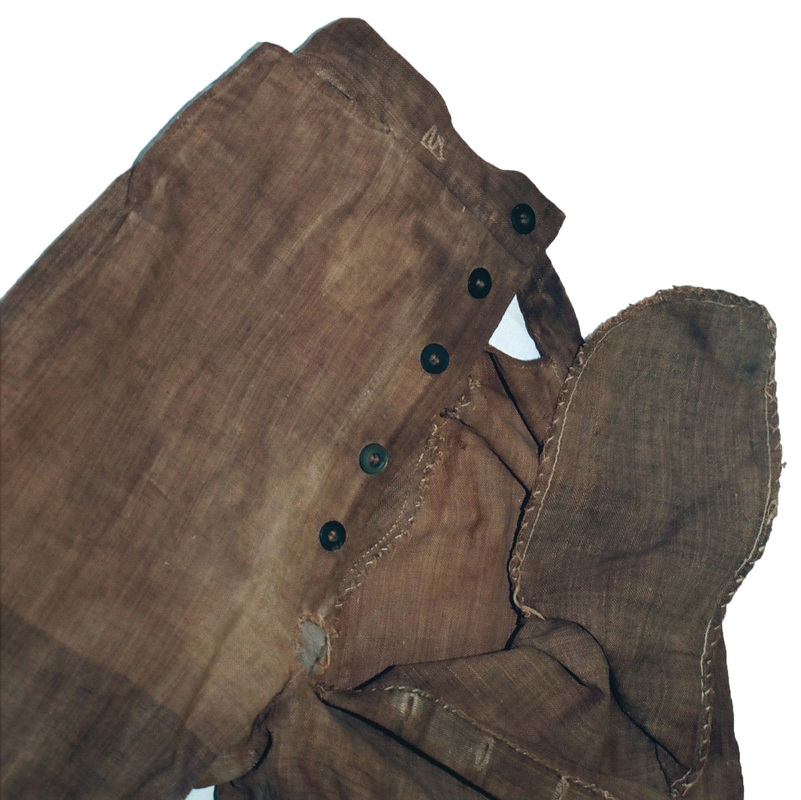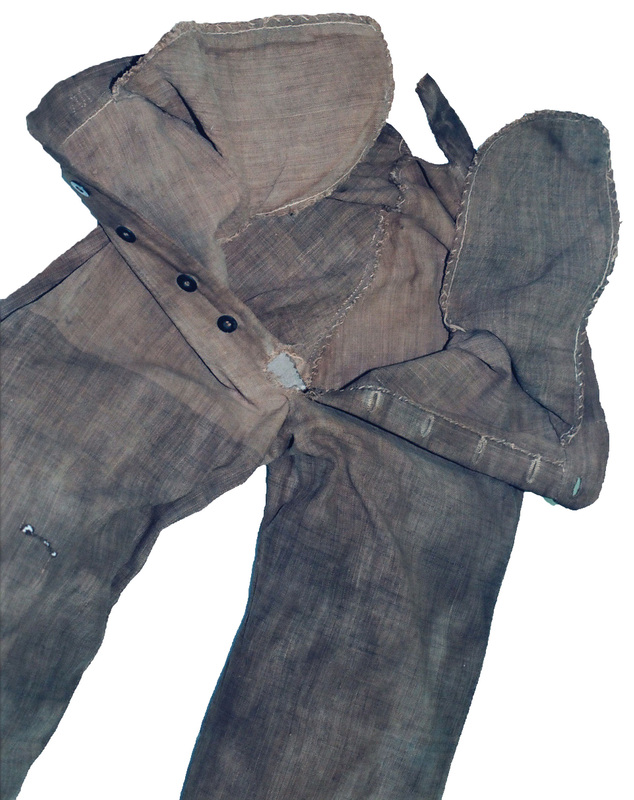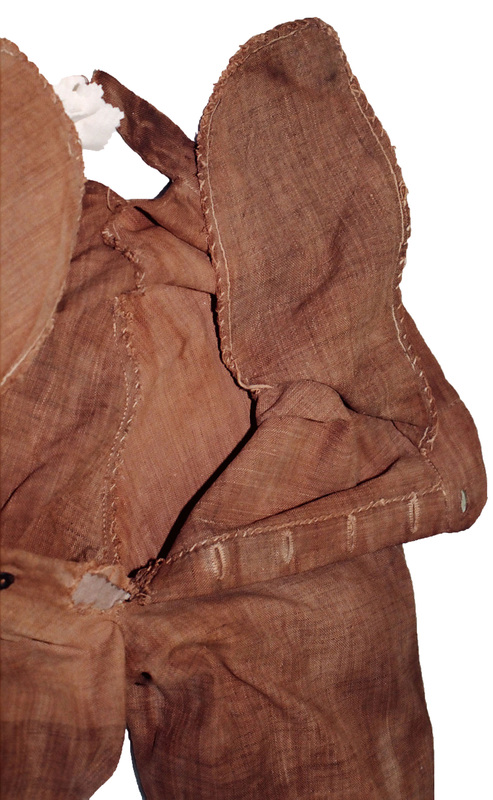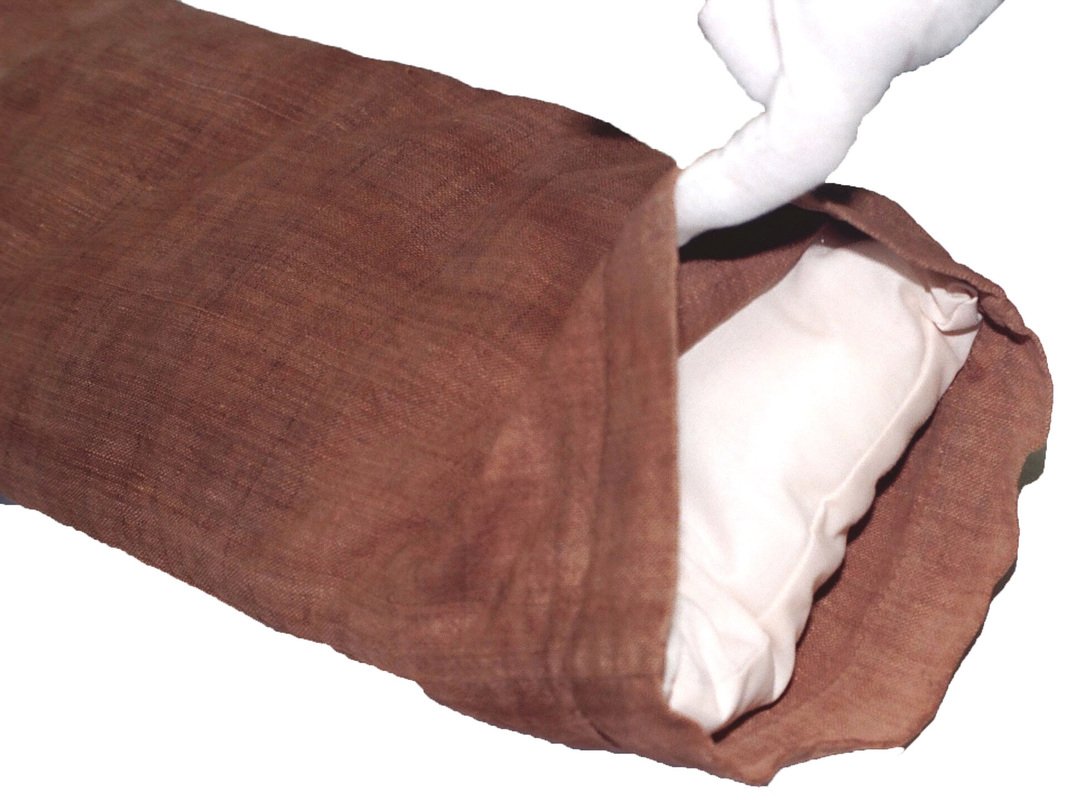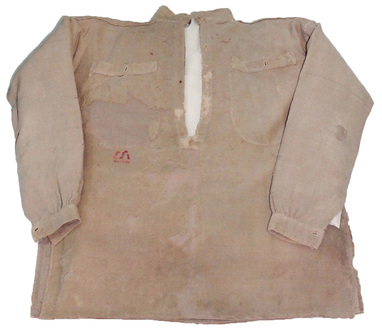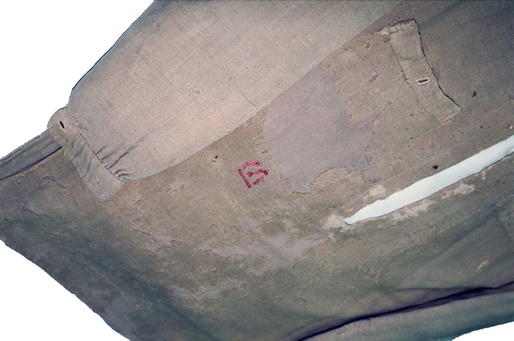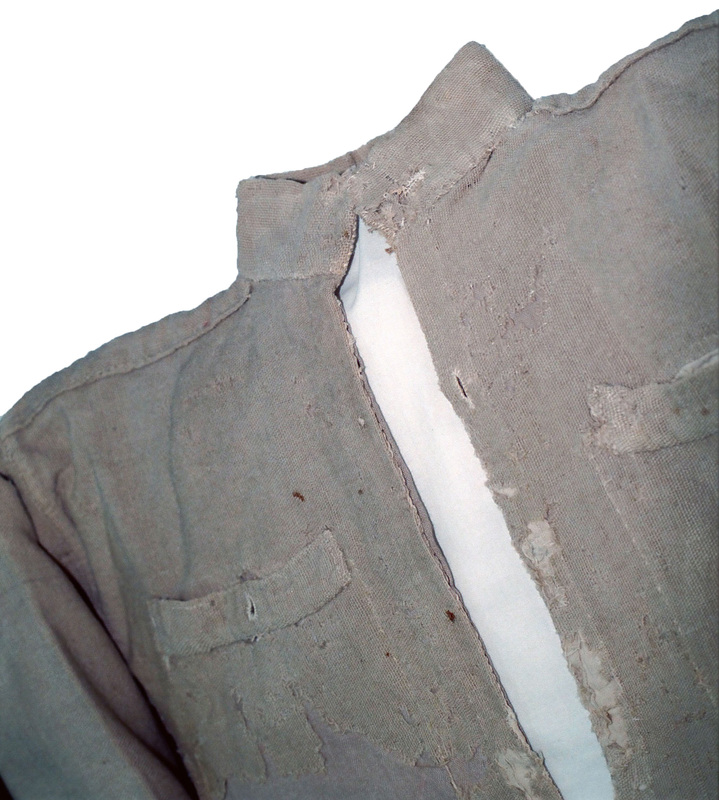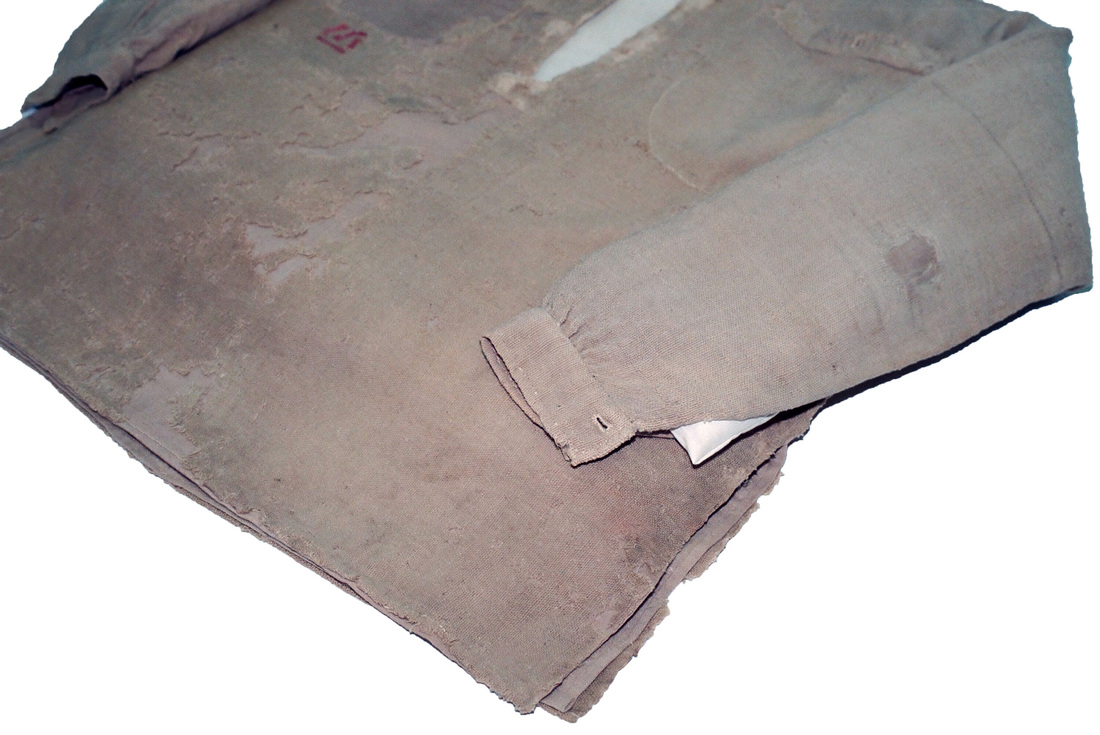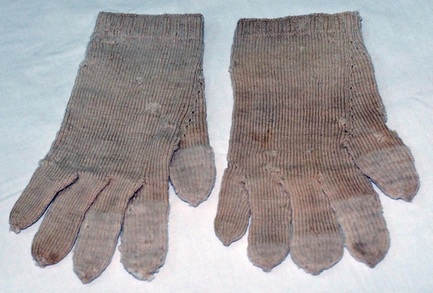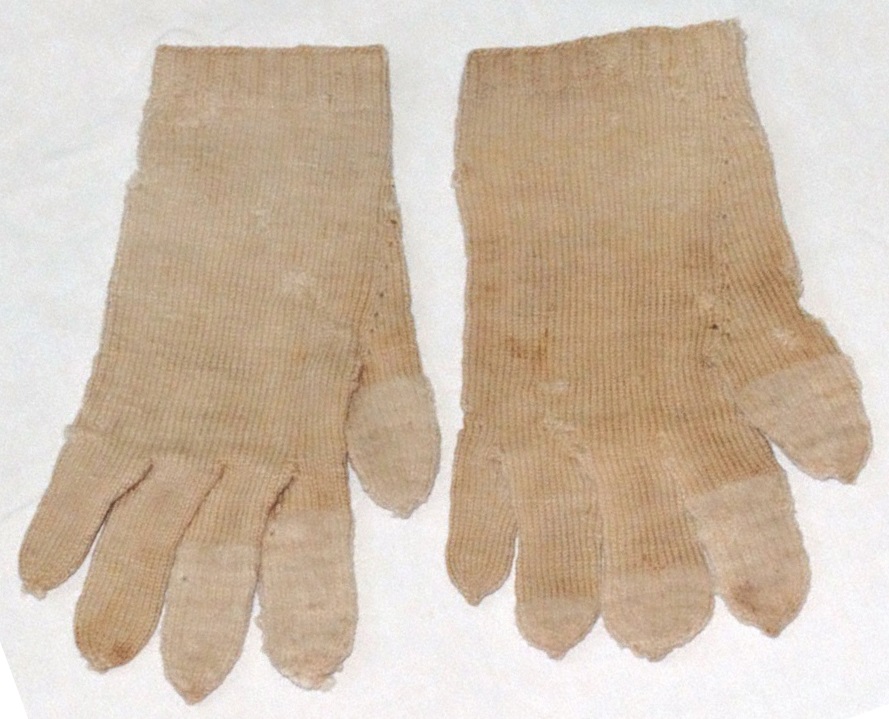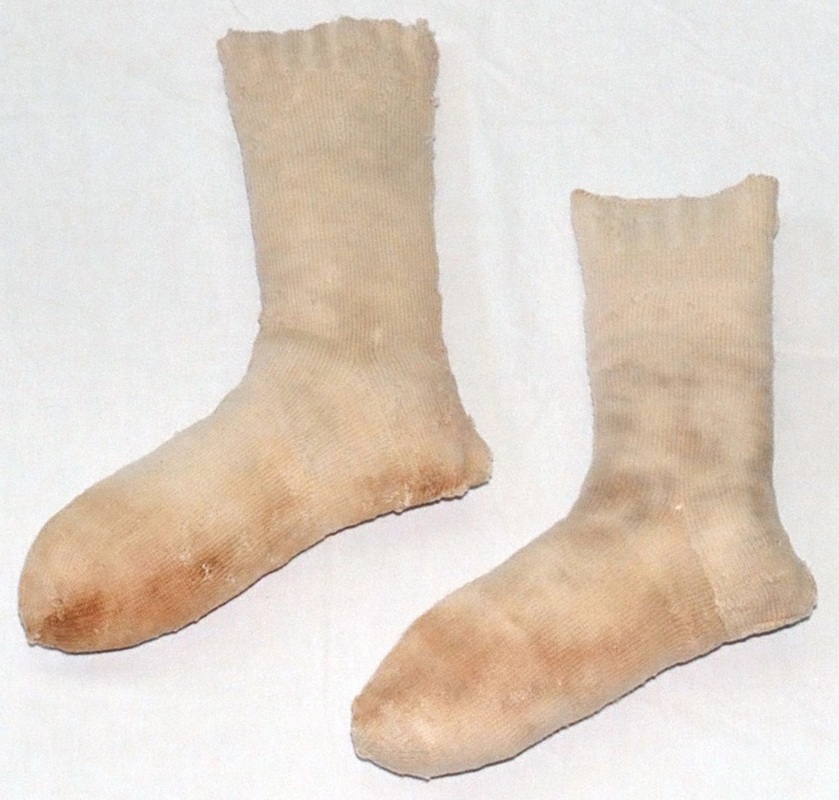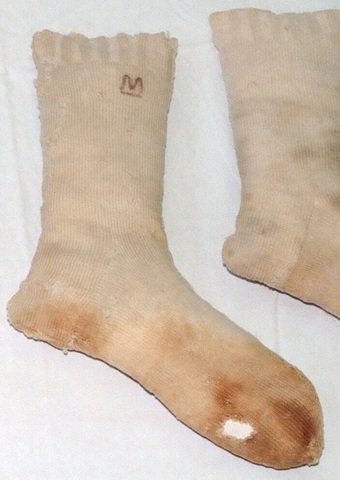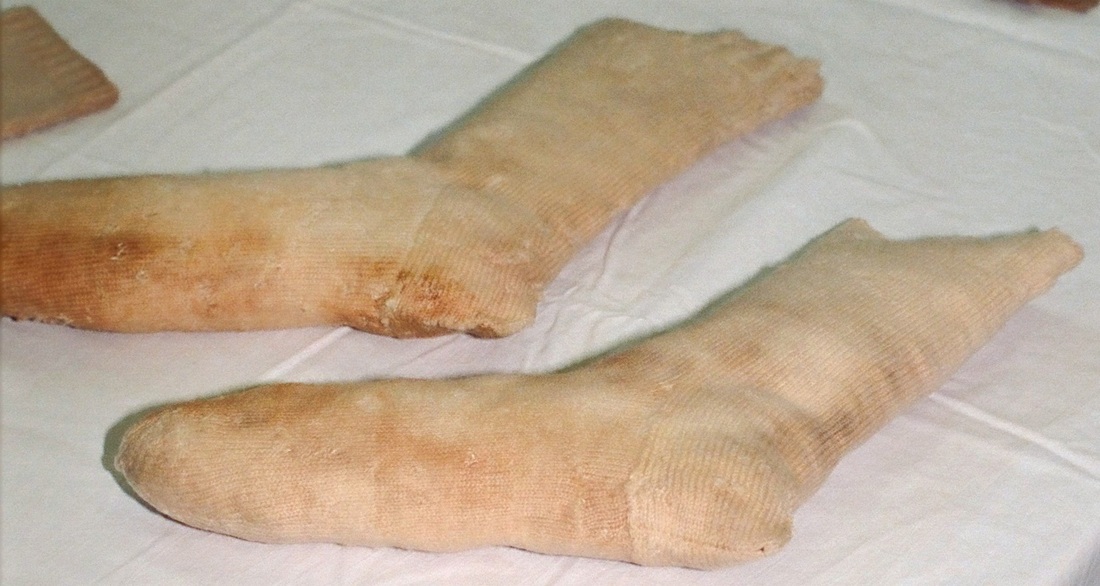The
Homemade Confederate Clothes of Burton Marchbanks, 30th Texas Cavalry
By Fred Adolphus, 5 June 2014
By Fred Adolphus, 5 June 2014
Private
Burton Marchbanks, Company E, 30th Texas Cavalry, left to posterity one of the
most intact and representative sets of homemade, butternut, citizens clothes
used by Confederate soldiers anywhere. The collection consists of a sort of frock coat known as a "paletot;" a pair of pants; a pair of socks; an over shirt; and a pair of gloves.
Uniformologists often disregard how common homemade citizen clothing was
common in Confederate ranks, and Marchbanks's clothing refocuses our attention on
its prominent role in clothing Confederate troops. Citizen clothing augmented shortfalls in government
issues, offered a better fit, was made to a desired style, and had immense
sentimental value, having come from the hands of the soldiers' own womenfolk.
Numerous anecdotes attest to the prolific use of butternut citizen clothes by regular Confederate soldiers. Lieutenant Colonel James Fremantle alludes to soldiers' preference for homemade clothes in his diary. He noted that General Liddell’s Arkansas Brigade was “well clothed, though without any attempt at uniformity in color or cut; but nearly all were dressed either in gray or brown coats and felt hats,” and “…that even if a regiment was clothed in proper uniform by the government, it would become partli-colored again in a week, as the soldiers preferred wearing the coarse homespun jackets and trousers made by their mothers and sisters at home. The generals wisely allow them to please themselves in this respect, and insist only upon their arms and accoutrements being kept in proper order.”[i]
Trans-Mississippi soldier Henry Orr, of the 12th Texas Cavalry, asked his family in September 1863 to send his brother Robert a jeans "frock or dress coat," and him a jeans dress coat, "... or sack of the loose wrapper style; one similar to the one you sent me last fall...".[ii] Soldiers were also fond of over shirts. Another Orr brother, Lafayette, asked his mother in September 1862 to make him and his brother James some "geens" [jeans] over shirts, dyed purple and brown. Henry made a similar request of his mother the same month, asking that she send him and his brother Robert, some linsey or cotton over shirts. A year later, Henry asked his parents to send him and Robert two woolen over shirts, each with two pockets.[iii] Henry Orr also requested his parents send him "a heavy jeans, well lined overcoat" in September 1862.[iv] Other garments frequently requested were socks, pants, drawers, and shirts (especially colorful ones). In fact, considering the wide array in color and patterns of shirts worn in the Trans-Mississippi, it is little wonder that a soldier in Walker’s Greyhound Division stated of a Texas cavalry brigade that, "Their uniform contained as many colors as the rainbow."[v]
Apparently, little effort was made to ensure that homemade clothing looked military. Henry Orr's company dispatched a detail home in September 1863 to collect clothing from the families for men in his company. Orr remarked that, “Captain Veal wishes his company as nearly uniform as possible and requires that the coat and pants be gray jeans (or black and white sheep's wool), but suit your convenience about this for gray or brown either will suit Robert and myself; indeed, we will be glad to get anything home-made, for clothing we get here is very trifling."[vi] As it turned out, the company drew government clothing in October, giving the troops a choice of what to wear.[vii]
Homespun clothes were almost universally brown, as families used walnut hulls to dye their homespun yarn or cloth. Walnut stain is remarkably color fast, even without a mordant, and it imparted a warm, light to medium brown shade. Henry Orr compared Magruder's staff to the rank and file in 1864, by writing, "Stars and brass buttons are as common there [Camden, Arkansas] as brown jeans in the 12th Texas".[viii] Early in the war, before imported cadet gray kersey was available, brown was even common among officers. An Arkansas soldier, Silas Claiborn Turnbo noted that General Henry McCulloch wore a "home-made brown suit of jeans" in 1863 and could scarcely be distinguished from a private soldier.[ix] Families could also make gray jeans without dyestuffs by mixing white and black wool into yarn. Bill Witherspoon, of Forrest's cavalry in Mississippi, described how his family had made him a short jacket and matching pants from gray cloth made this way.[x]
Returning to Burton Marchbanks, he was 32 years old when he joined Gurley's 30th Texas Cavalry for three years on July 12, 1862 at Camp McCulloch, Buchanan, Texas. The command also used the designation "1st Texas Partisan Rangers." Marchbanks provided his own horse and equipment, valued respectively at $200.00 and $25.00 each, when he enlisted.
The regiment served from its organization in the summer of 1862 until the summer of 1863 in South Texas. At that time, it moved to the Indian Nations, where it fought at the Battle of Honey Springs on July 17, 1863. The regiment suffered several casualties, among them Marchbanks, who was severely wounded and captured. He was subsequently paroled, and then discharged from the service on August 8, 1863. He returned home and died of his wounds shortly thereafter.
The regiment fought during the Camden Campaign in Arkansas during the spring of 1864, and at Poison Spring and Cabin Creek in the Indian Nations. It transferred back to Texas, and was assigned to Parsons's Brigade in March of 1865. That same month, the regiment was ordered dismounted, but it successfully protested the order, and had the order countermanded. The 30th Texas disbanded in May 1865.
Numerous anecdotes attest to the prolific use of butternut citizen clothes by regular Confederate soldiers. Lieutenant Colonel James Fremantle alludes to soldiers' preference for homemade clothes in his diary. He noted that General Liddell’s Arkansas Brigade was “well clothed, though without any attempt at uniformity in color or cut; but nearly all were dressed either in gray or brown coats and felt hats,” and “…that even if a regiment was clothed in proper uniform by the government, it would become partli-colored again in a week, as the soldiers preferred wearing the coarse homespun jackets and trousers made by their mothers and sisters at home. The generals wisely allow them to please themselves in this respect, and insist only upon their arms and accoutrements being kept in proper order.”[i]
Trans-Mississippi soldier Henry Orr, of the 12th Texas Cavalry, asked his family in September 1863 to send his brother Robert a jeans "frock or dress coat," and him a jeans dress coat, "... or sack of the loose wrapper style; one similar to the one you sent me last fall...".[ii] Soldiers were also fond of over shirts. Another Orr brother, Lafayette, asked his mother in September 1862 to make him and his brother James some "geens" [jeans] over shirts, dyed purple and brown. Henry made a similar request of his mother the same month, asking that she send him and his brother Robert, some linsey or cotton over shirts. A year later, Henry asked his parents to send him and Robert two woolen over shirts, each with two pockets.[iii] Henry Orr also requested his parents send him "a heavy jeans, well lined overcoat" in September 1862.[iv] Other garments frequently requested were socks, pants, drawers, and shirts (especially colorful ones). In fact, considering the wide array in color and patterns of shirts worn in the Trans-Mississippi, it is little wonder that a soldier in Walker’s Greyhound Division stated of a Texas cavalry brigade that, "Their uniform contained as many colors as the rainbow."[v]
Apparently, little effort was made to ensure that homemade clothing looked military. Henry Orr's company dispatched a detail home in September 1863 to collect clothing from the families for men in his company. Orr remarked that, “Captain Veal wishes his company as nearly uniform as possible and requires that the coat and pants be gray jeans (or black and white sheep's wool), but suit your convenience about this for gray or brown either will suit Robert and myself; indeed, we will be glad to get anything home-made, for clothing we get here is very trifling."[vi] As it turned out, the company drew government clothing in October, giving the troops a choice of what to wear.[vii]
Homespun clothes were almost universally brown, as families used walnut hulls to dye their homespun yarn or cloth. Walnut stain is remarkably color fast, even without a mordant, and it imparted a warm, light to medium brown shade. Henry Orr compared Magruder's staff to the rank and file in 1864, by writing, "Stars and brass buttons are as common there [Camden, Arkansas] as brown jeans in the 12th Texas".[viii] Early in the war, before imported cadet gray kersey was available, brown was even common among officers. An Arkansas soldier, Silas Claiborn Turnbo noted that General Henry McCulloch wore a "home-made brown suit of jeans" in 1863 and could scarcely be distinguished from a private soldier.[ix] Families could also make gray jeans without dyestuffs by mixing white and black wool into yarn. Bill Witherspoon, of Forrest's cavalry in Mississippi, described how his family had made him a short jacket and matching pants from gray cloth made this way.[x]
Returning to Burton Marchbanks, he was 32 years old when he joined Gurley's 30th Texas Cavalry for three years on July 12, 1862 at Camp McCulloch, Buchanan, Texas. The command also used the designation "1st Texas Partisan Rangers." Marchbanks provided his own horse and equipment, valued respectively at $200.00 and $25.00 each, when he enlisted.
The regiment served from its organization in the summer of 1862 until the summer of 1863 in South Texas. At that time, it moved to the Indian Nations, where it fought at the Battle of Honey Springs on July 17, 1863. The regiment suffered several casualties, among them Marchbanks, who was severely wounded and captured. He was subsequently paroled, and then discharged from the service on August 8, 1863. He returned home and died of his wounds shortly thereafter.
The regiment fought during the Camden Campaign in Arkansas during the spring of 1864, and at Poison Spring and Cabin Creek in the Indian Nations. It transferred back to Texas, and was assigned to Parsons's Brigade in March of 1865. That same month, the regiment was ordered dismounted, but it successfully protested the order, and had the order countermanded. The 30th Texas disbanded in May 1865.
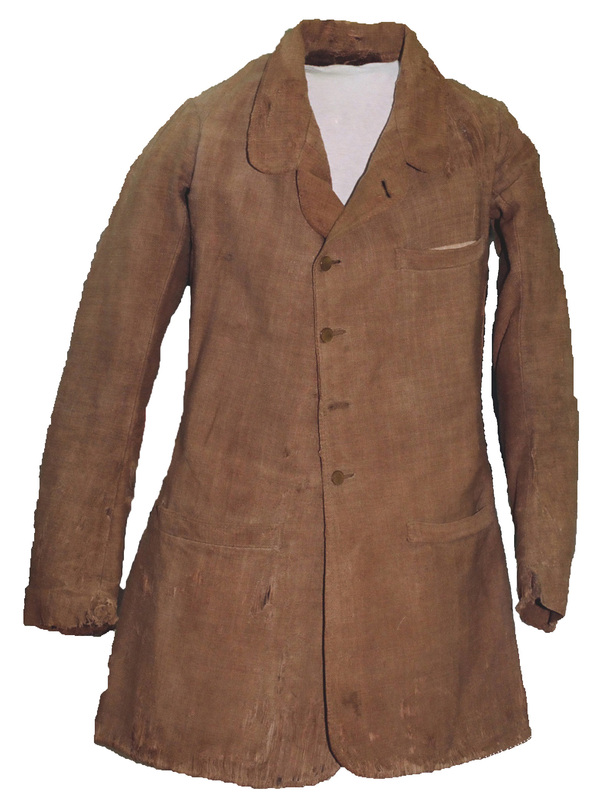
Image 2: Marchbanks's homemade frock coat (paletot) was made from home-dyed, homespun cloth: a plain-weave, lightweight woolen fabric, rather loosely woven. The yarns are narrow and tight. It appears that the yarn was dyed on the skein (before it was woven). The cloth has been cut on the bias for most pieces, perhaps not intentionally so. The frock features three outside pockets (two lower pockets, and one at the left breast), and two piece sleeves. The distinctive paletot tailoring had a front cut like a sack coat and the rear cut like a frock.
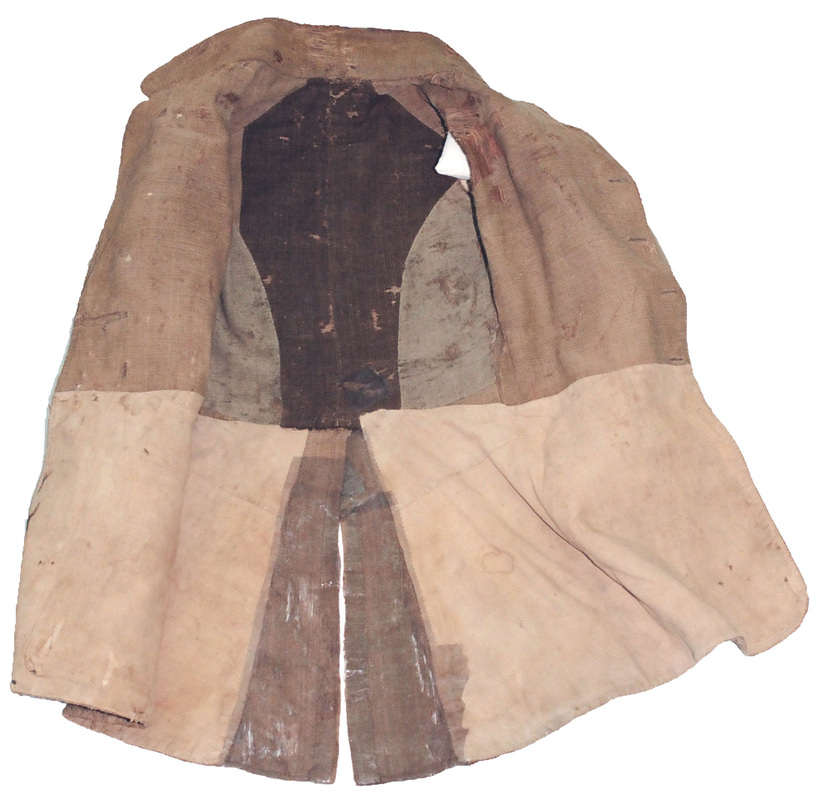
Image 9: The lining is composed of several different fabrics, reflecting the thrifty practice of using whatever small pieces were available to Marchbanks's womenfolk. The front piece linings to the waist, and the back tail pieces below the waist, are made of the basic cloth; the side pieces of a pale greenish-tan lining; the back pieces above the waist of dark brown lining, and the skirt lining of unbleached osnaburg.
The author extends his gratitude to the Layland Museum of Cleburne, Texas, and its staff for facilitating the viewing and research of the Marchbanks collection. Special thanks is extended to Curator Julie Baker, Assistant Curator Jill Curry, and Museum Intern Amy Little for their kind help during my visit in June 1997. Readers are reminded that the images herein are the property of Adolphus Confederate Uniforms. The portrait of Marchbanks is the property of the Layland Museum, and is likewise under copyright protection. Please do not reproduce these images without the obtaining the author's consent.
Bibliography
[i] Lord, Walter; The Fremantle Diary: Being the Journal of Lieutenant Colonel James Lyon Arthur Fremantle, Coldstream Guards, on his Three Months in the Southern States, Little, Brown & Company, Boston, 1954, p. 124, Army of Tennessee at Bellbuckle, Tennessee, June 1, 1863, (hereafter, Fremantle).
[ii]. Anderson, John Q. Campaigning with Parsons' Texas Cavalry Brigade, CSA: The War Journal and Letters of the Four Orr Brothers, 12th Texas Cavalry Regiment, The Hill Junior College Press, Hillsboro, Texas, 1967, pp. 118-119, North Louisiana, (Hereafter, Anderson).
[iii]. Anderson, pp. 69, 71-72 & 118-119.
[iv]. Anderson, p. 71.
[v]. Blessington, Joseph Palmer, The Campaigns of Walker's Texas Division, State House Press, Austin, Texas, 1994, pp. 113-114, May 28, 1863, vicinity Milliken's Bend, Louisiana.
[vi]. Anderson, pp. 118-119.
[vii]. Anderson, pp. 118-119 & 123.
[viii]. Anderson, p. 150, November 1864.
[ix]. Turnbo, Silas C., History of the Twenty-Seventh Arkansas Confederate Infantry, Arkansas Research, Conway, Arkansas, 1993, p. 82, Dehli, Louisiana, June 11, 1863.
[x]. Henry, Robert Selph, As They Saw Forrest, Broadfoot Publishing, Wilmington, North Carolina, 1987, pp. 74, 79, ca. 1863, Mississippi.
Bibliography
[i] Lord, Walter; The Fremantle Diary: Being the Journal of Lieutenant Colonel James Lyon Arthur Fremantle, Coldstream Guards, on his Three Months in the Southern States, Little, Brown & Company, Boston, 1954, p. 124, Army of Tennessee at Bellbuckle, Tennessee, June 1, 1863, (hereafter, Fremantle).
[ii]. Anderson, John Q. Campaigning with Parsons' Texas Cavalry Brigade, CSA: The War Journal and Letters of the Four Orr Brothers, 12th Texas Cavalry Regiment, The Hill Junior College Press, Hillsboro, Texas, 1967, pp. 118-119, North Louisiana, (Hereafter, Anderson).
[iii]. Anderson, pp. 69, 71-72 & 118-119.
[iv]. Anderson, p. 71.
[v]. Blessington, Joseph Palmer, The Campaigns of Walker's Texas Division, State House Press, Austin, Texas, 1994, pp. 113-114, May 28, 1863, vicinity Milliken's Bend, Louisiana.
[vi]. Anderson, pp. 118-119.
[vii]. Anderson, pp. 118-119 & 123.
[viii]. Anderson, p. 150, November 1864.
[ix]. Turnbo, Silas C., History of the Twenty-Seventh Arkansas Confederate Infantry, Arkansas Research, Conway, Arkansas, 1993, p. 82, Dehli, Louisiana, June 11, 1863.
[x]. Henry, Robert Selph, As They Saw Forrest, Broadfoot Publishing, Wilmington, North Carolina, 1987, pp. 74, 79, ca. 1863, Mississippi.
